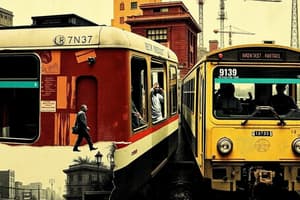Podcast
Questions and Answers
What is the primary objective of the National Urban Transport Policy?
What is the primary objective of the National Urban Transport Policy?
To plan for the people rather than vehicles by providing sustainable mobility and accessibility to all citizens.
Which of the following is NOT a focus area of the National Urban Transport Policy?
Which of the following is NOT a focus area of the National Urban Transport Policy?
- Reduce pollution
- Enhance public transport
- Increase vehicle usage (correct)
- Improve urban mobility
The urban transport sector is the largest consumer of energy in India.
The urban transport sector is the largest consumer of energy in India.
False (B)
By 2030, cities are expected to contribute approximately ______% to the nation's GDP.
By 2030, cities are expected to contribute approximately ______% to the nation's GDP.
Which three key strategies are encouraged for urban transport planning?
Which three key strategies are encouraged for urban transport planning?
What does TDM stand for in the context of urban transport planning?
What does TDM stand for in the context of urban transport planning?
What is a significant reason for the increase in personal vehicle use in India?
What is a significant reason for the increase in personal vehicle use in India?
Urban Transport Planning should prioritize modes in the following order: walk, non-motorized transport (NMT), ______, and personal motorized transport.
Urban Transport Planning should prioritize modes in the following order: walk, non-motorized transport (NMT), ______, and personal motorized transport.
What significant investment is projected for enhancing urban services over the next 20 years?
What significant investment is projected for enhancing urban services over the next 20 years?
Flashcards are hidden until you start studying
Study Notes
Current Situation
- Urban transport (UT) is essential for addressing energy conservation, pollution control, and poverty alleviation.
- India faces significant deficits in UT services and infrastructure concerning quality and quantity.
- Decline in pedestrian, cycling, and public transport use; increased reliance on cars and two-wheelers leading to congestion, reduced road safety, and rising pollution.
Future Projections
- Ongoing urbanization may worsen these issues significantly without intervention.
- TERI predicts India’s energy demand and emissions could rise six to seven times by 2031-32 under a 'business as usual' outcome.
- Road accidents are expected to increase by 50% from 2005 to 2015, illustrating growing safety concerns.
- Urban areas are crucial for GDP, expected to contribute 70% by 2030; efficient urban transport enables workforce mobility.
Transport Sector Overview
- Transport is the second-largest energy consumer in India, with urban vehicle reliance visibly increasing environmental issues.
- The vision includes putting people at the center of city planning to enhance well-being and economic growth.
Policy Objectives
- Sustainable mobility for all citizens, facilitating access to jobs, education, and services at affordable costs.
- Emphasis on integrating urban transport planning progressively rather than merely as an afterthought.
- Proposing equitable road space allocation emphasizing pedestrian and cycling safety.
Proposed Strategies
- Enhance public transport (PT) systems to be citywide, efficient, reliable, and user-friendly.
- Implement intelligent transport systems for improved traffic management and road safety.
- Develop innovative financial mechanisms and improve coordination among agencies involved in transportation planning.
Investment Needs
- More than 50% of urban service improvement investment must focus on public transport and urban roads, amounting to over ₹1 lakh crore annually for 20 years.
- Sustainable practices could reduce investment needs by nearly 30%.
Transport Planning Approach
- Adopt ‘Avoid, Shift, Improve’ strategies in transport planning to enhance urban mobility and alleviate poverty.
- Integrated planning should encompass local and peri-urban areas emphasizing compact cities and mixed land use to manage transport demand.
Comprehensive Mobility Planning
- Mobility is influenced by multiple factors: UT services and modes, infrastructure, and ancillary planning matters.
- Prioritized planning should favor walking and non-motorized transport (NMT) over personal vehicles.
Transit-Oriented Development (TOD)
- TOD centers housing, jobs, and amenities around public transport stations to promote usage and connectivity.
- Plaza-like environments near transit hubs encourage pedestrian access and community integration.
Transportation Demand Management (TDM)
- Need to control transport demand growth while improving infrastructure quality.
- TDM policies aim to promote sustainable travel options and enhance commuter awareness of alternatives and their benefits.
Controlling Personal Vehicle Use
- Personal vehicles significantly contribute to urban air pollution and emissions; improving public transport quality is essential for reducing personal vehicle reliance.
Freight Traffic Planning
- As urban industries grow, balancing freight and passenger transport timing is vital for maintaining efficient UT infrastructure.
Service Level Benchmarks (SLB)
- Investment in UT should be guided by assessing service levels, with a focus on enhancing performance periodically.
Participatory Planning Approach
- Encouraging public participation in transportation planning fosters alignment with community needs and acceptance of services.
- Diverse methods for engaging citizens include workshops, surveys, and interactive platforms to gather input and feedback.
Studying That Suits You
Use AI to generate personalized quizzes and flashcards to suit your learning preferences.




